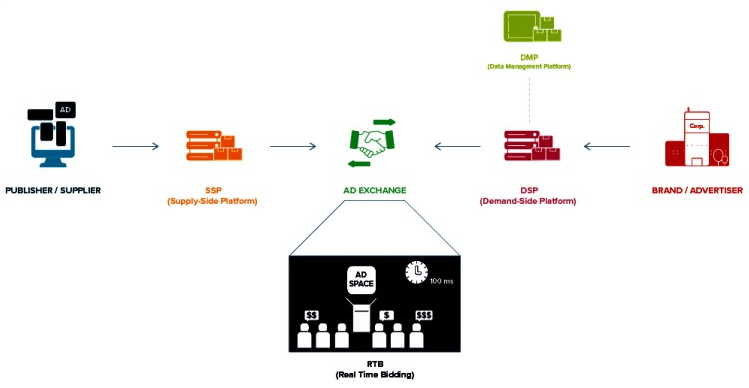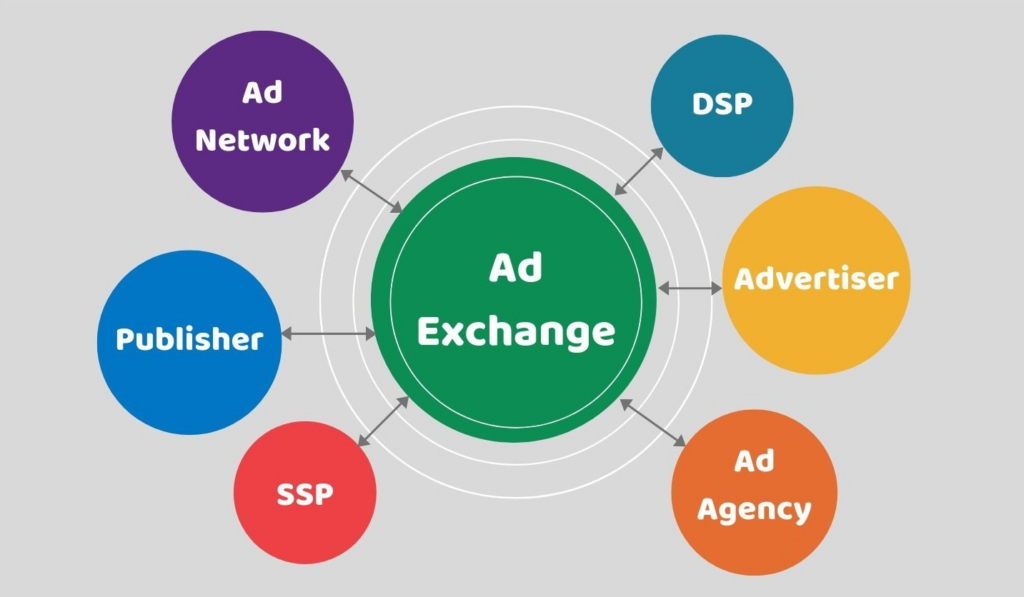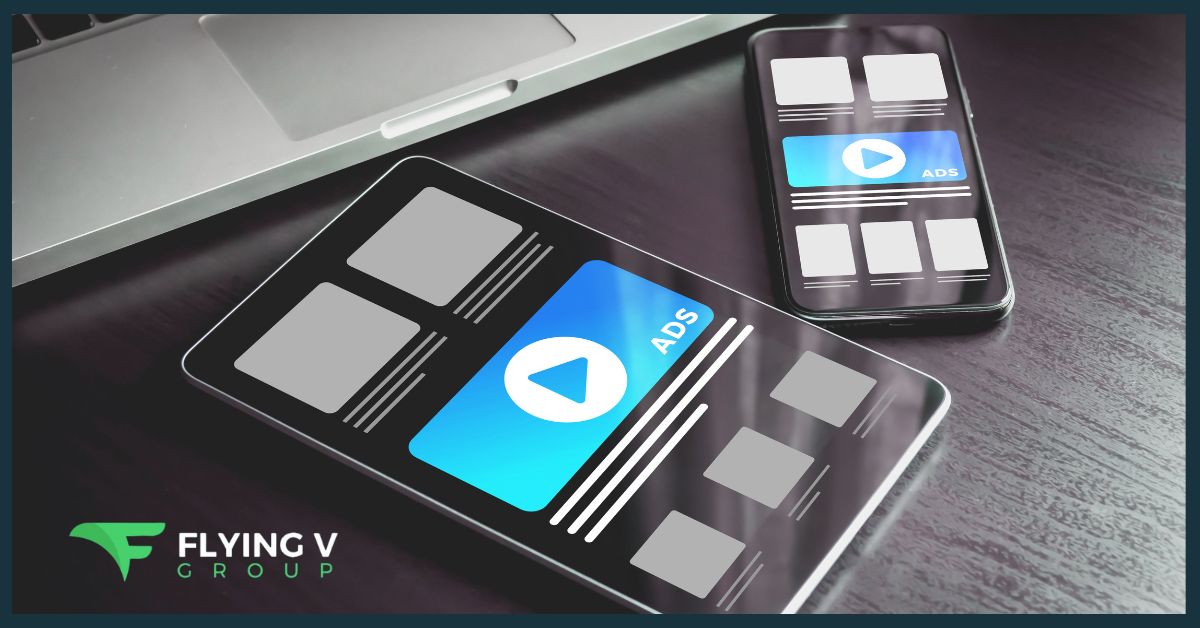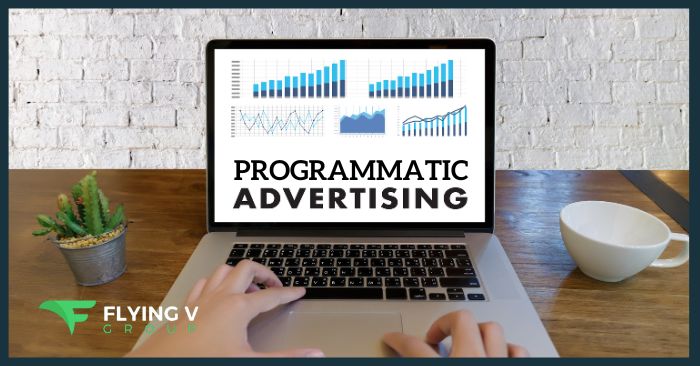Struggling to grasp ‘What is Programmatic Advertising?’ You’re not alone. Many entrepreneurs find traditional advertising methods complex and inefficient.
Programmatic advertising is the answer, revolutionizing ad placements with its data-driven, automated approach.
At Flying V Group, our experience spans collaborations with some of the leading companies in the US, such as Bliss Car Wash. This has equipped us with tried-and-true programmatic advertising tactics that consistently deliver in diverse markets.
In this article, we’ll explore how it simplifies advertising, ensuring your ads reach the right audience effectively, boosting your marketing ROI. Let’s demystify this modern advertising strategy, making it a powerful asset in your business toolkit.
What Is Programmatic Advertising?
Programmatic advertising refers to the use of automated technology for buying and selling online advertising space.
This process uses algorithms and real-time bidding (RTB) to allow for efficient and targeted ad placements across various digital platforms.
Unlike traditional advertising methods, which involve manual negotiations and pre-set pricing, programmatic advertising leverages data and machine learning to make instantaneous decisions about what ads to display, where, and to whom.
The essence of programmatic advertising lies in its precision and efficiency. By analyzing vast amounts of data — including user behavior, preferences, and engagement — it ensures that the right ads are shown to the right audience at the most opportune time.
This not only enhances the chances of ad success but also maximizes the return on investment (ROI) for advertisers.
What’s The Difference Between Programmatic And Display Ads?
While often used interchangeably, programmatic and display advertising are distinct concepts with unique characteristics.
Display Advertising refers to the visual ads on websites, apps, and social media. These banners, video ads, or interactive media are a significant part of online marketing strategies.
Display advertising is about the ad’s format and creative aspect, focusing on how it appears and attracts the audience.
Programmatic Advertising, conversely, is more about the strategy and mechanism behind the ad placements. It uses technology to automate these display spaces’ buying and selling process.
The key difference lies in how the ad space is purchased and optimized. In programmatic advertising, the process is automated and driven by data, targeting specific audiences in real-time based on algorithms, which is not necessarily the case in traditional display advertising.
While display ads are the actual visual advertisements you see online, programmatic advertising is used to automate buying the ad spaces where these display ads are shown.
This automation is data-driven and highly efficient, ensuring that display ads reach their intended audience most effectively.
What are Programmatic Advertising Platforms and Tools?

Programmatic advertising platforms and tools automate and optimize the process of buying and selling digital advertising space, using advanced algorithms and real-time data. These technologies cater to different aspects of the advertising chain, from buying to selling and data management.
Let’s explore each type of platform, how it can help beginner entrepreneurs, along with examples, practical tips, and challenges to consider.
Demand-Side Platforms (DSPs)
DSPs allow advertisers to purchase ad inventory automatically. They provide a platform to manage multiple ad exchange and data exchange accounts, optimizing ad spend by targeting specific audiences using real-time data.
How DSPs Help Beginners: They simplify the ad buying process, allowing for targeted advertising and efficient budget allocation.
Examples: The Trade Desk, MediaMath, Adobe Advertising Cloud.
Tips for Beginners
- Begin with a modest budget to understand the DSP functionality.
- Choose DSPs with intuitive interfaces and strong customer support.
Challenges:
- Complexity in understanding targeting options.
- Navigating the bidding process and budget allocation.
Supply-Side Platforms (SSPs)
SSPs are used by publishers to sell ad space automatically. They optimize the fill rate and ensure inventory is sold at the highest price.
How SSPs Help Beginners: SSPs maximize revenue for publishers by connecting them to a wide network of advertisers.
Examples: Google Ad Manager, OpenX, PubMatic.
Tips for Beginners:
- Focus on platforms that offer transparency in terms of pricing and inventory access.
- Monitor performance analytics to understand inventory value.
Challenges:
- Balancing ad revenue with user experience.
- Managing the fill rate and eCPM (effective Cost Per Mille).
Data Management Platforms (DMPs):
DMPs collect and analyze data to provide insights into audience segments.
How DMPs Help Beginners: They offer valuable insights for targeted advertising strategies.
Examples: Lotame, Oracle BlueKai, Adobe Audience Manager.
Tips for Beginners:
- Use DMPs to gain a deeper understanding of your audience.
- Integrate DMP data with your DSP for more effective targeting.
Challenges:
- Data integration and interpretation.
- Ensuring data privacy compliance.
Ad Exchanges:

Ad Exchanges are digital marketplaces facilitating the buying and selling of ad spaces between DSPs and SSPs.
How Ad Exchanges Help Beginners: They provide access to a vast range of ad inventory in real-time.
Examples: DoubleClick by Google, AppNexus, Rubicon Project.
Tips for Beginners:
- Understand the types of inventory available and their relevance to your audience.
- Start with basic bidding strategies and evolve as you learn.
Challenges:
- Competing with other advertisers in real-time bidding environments.
- Understanding the value of different types of ad inventory.
Real-Time Bidding (RTB) Platforms:
RTB platforms enable instantaneous bidding on ad inventory.
How RTB Helps Beginners: RTB allows for precise targeting and immediate execution of ad buying.
Examples: Criteo, PubMatic, Smaato.
Tips for Beginners:
- Monitor bid performance and adjust strategies accordingly.
- Use RTB for time-sensitive or highly targeted campaigns.
Challenges:
- Rapid decision-making required in the RTB environment.
- Balancing bid amounts with potential ROI.
By understanding and leveraging these platforms and tools, beginner entrepreneurs can effectively navigate the complex world of digital advertising, ensuring their ads reach the right audience, thus maximizing engagement and revenue.
How and Why is Programmatic Advertising Successful?
Programmatic advertising is notably successful for its targeted campaigns and smart use of technology, including:
1. Targeted Campaigns:
Unlike traditional ads, which often miss their intended audience, programmatic advertising uses data to precisely target specific groups. John Lincoln of Ignite Visibility says, “Programmatic advertising is designed to do away with old-fashioned, hit-or-miss campaign design.” This results in ads that are more engaging, convert better, and offer a higher return on investment.
2. Algorithm-Driven Optimization:
It leverages algorithms to smartly allocate ad budgets. Lincoln explains, “With programmatic advertising, you can rely on an algorithm that will determine where your ad money is best spent.” This means advertisers can set their campaign parameters, and the system efficiently manages everything from there.
3. Continuous Improvement:
Programmatic advertising is always learning and adapting. Lincoln notes, “The system will not only launch your campaign, but it will also monitor your ad spend to look for areas of improvement.” This ongoing optimization ensures that the advertising strategy remains effective even as market conditions and consumer behaviors change.
How can you succeed with programmatic advertising?
To effectively leverage programmatic advertising, it’s crucial to understand and apply key strategies:
- Set Clear Objectives and Key Performance Indicators (KPIs)
Define specific goals for your campaigns, such as increasing brand awareness or driving sales, and establish measurable KPIs to track their performance.
- Understand Your Audience
Gather insights into your audience’s behaviors and preferences using data management platforms for precise targeting and personalized ad experiences.
- Choose the Right Platforms and Tools
Select DSPs, SSPs, and other tools that align with your advertising objectives, considering their features, user interface, and budget flexibility.
By following these condensed strategies, businesses can effectively harness the potential of programmatic advertising to meet their marketing objectives.
Programmatic Advertising Examples
To illustrate the effectiveness of programmatic advertising, let’s look at two real-world examples:
1. Coca-Cola’s Outdoor Ads
Coca-Cola used programmatic ads on digital billboards, tailoring content based on weather, time, and traffic. For example, ads for cold drinks appeared on hot days, aligning with immediate consumer needs.
2. Airbnb’s Personalized Campaigns
Airbnb created dynamic ads based on user searches. If someone looked for a place but didn’t book, they saw personalized ads for similar locations, boosting re-engagement and bookings.
These cases show how real-time data and audience insights can make programmatic advertising highly effective and adaptable across various sectors.
Facing Challenges in Programmatic Advertising? Let Flying V Group Be Your Solution
Programmatic advertising can be daunting, with its complexities and ever-evolving nature often overwhelming even seasoned marketers. Here’s where Flying V Group steps in – to transform these challenges into opportunities.
With our deep expertise in programmatic advertising, we turn confusing data and trends into clear, actionable strategies that elevate your brand. Join us to navigate the digital landscape effortlessly and achieve the results you’ve always wanted.
FAQs
What is programmatic advertising?
Programmatic Advertising involves automated buying and selling of online ad space, using data and algorithms to target ads to specific audiences in real-time, making advertising more efficient and effective.
What are the 4 main components of programmatic?
The four main components of programmatic advertising are Demand-Side Platforms (DSPs), Supply-Side Platforms (SSPs), Data Management Platforms (DMPs), and Ad Exchanges, all working together to automate ad buying and selling.
What is the difference between programmatic advertising and digital advertising?
Programmatic advertising is a subset of digital advertising that uses automated technology for the buying and selling of digital ad space, unlike traditional digital advertising which often involves manual processes.
Is Facebook programmatic advertising?
Yes, Facebook programmatic advertising exists within its platform, allowing advertisers to use automated bidding and targeting tools for ad placements on Facebook’s extensive network.
How do I start programmatic advertising?
To start with Programmatic advertising, choose a Demand-Side Platform (DSP), set clear advertising goals, define your target audience, and create engaging ad content, followed by monitoring and optimization of campaigns.





0 Comments